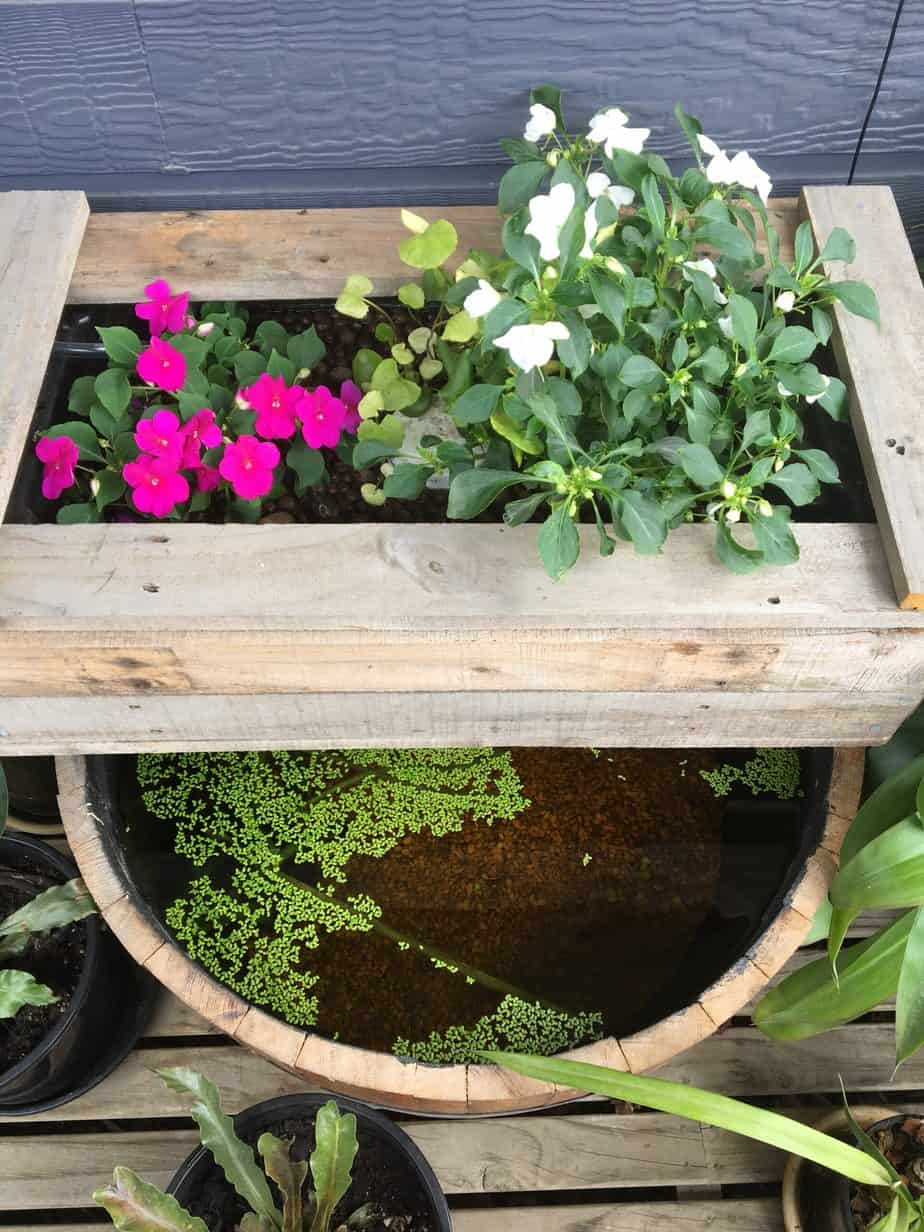I’m a lazy gardener. Yet I love my garden. I believe I should be able to spend time enjoying my landscape not labouring in it. My ponds are an integral part of the gardens around my home.
With the ponds my philosophy is the same. They need to basically take care of themselves. Yet I want crystal clear water and healthy fish. That’s why every pond I have has a bog filter.
A bog filter is the easiest way to maintain a healthy, vibrant and crystal clear pond.
So let’s take a quick look at all the reasons every pond owner should consider adding or incorporating a bog filter in their own pond.
If you’re already convinced and would like to construct one for your pond, here’s an article I wrote on “building a bog or wetland filter”.
Almost zero maintenance
I’m serious almost no maintenance at all!!
I might give my bog filters a flush out once a year. Compare that to a standard pond filter which needs constant back flushing to clean out the buildup of solids.
I’m sure some of you are very happy with your canister pond filters. A few pumps here and there and everything is clean.. but there’s still the wear and tear and eventually something breaks, jams, clogs or needs replacing.
Or if you have a filter/ pump combo you are constantly removing the unit to clean out all the debris that has been sucked in reducing your flow. There is a better way!
A bog filter has no moving parts. Of course you’ll still need a pump to move water into the filter but from there gravity does the rest.
The pump transports the solids to the bog where they get trapped and clean water returns to the pond.
Like I mentioned once a year I release the solids into the garden and that’s filter maintenance done for another year.
No algae
Algae is something ever pond owner has encountered and most of us hate it! It comes in many forms the single celled kind, that turn your water green and murky. Or the stringy kind that clings and clogs everything.
The most common cause of algae is too many nutrients and not enough biological filtration. Well guess what a bog filter is one big biological filter with the added benefit of plants, which will consume any excess nutrients.
The plant roots will also trap solid materials within the filter where they will slowly break down. This is a form of mechanical filtration.
Mechanical filtration is important because if the solid materials are allowed to build up within the pond they produce more nutrients as they decompose. More nutrients provides ideal conditions for algae growth.
By trapping the solids in the bog filter, the plants within the filter get first dibs on these new nutrients. Thus robbing the algae of the chance.
Healthy water
Solids, nutrients, even fish breathing adds different compounds into the water column. Without proper filtration these compounds will build up. Luckily nature has sorted out ways to break down harmful compounds into less harmful compounds.
It’s called the nitrogen cycle. Anybody who’s ever kept an aquarium should be familiar with the nitrogen cycle. Unfortunately many pond keepers don’t understand the nitrogen cycle. If you are one of those people consider reading my article “ a quick guide to the nitrogen cycle”.
Basically as organic materials breakdown and the fish within the pond breathe, ammonia is released. Ammonia in even small amounts is toxic to fish.
Beneficial bacteria are needed to transform the ammonia into nitrite and then into nitrate.
A bog filter provides a haven for beneficial bacteria. All the water from the pond is moved through the bog filter and thus comes into direct contact with billions of busy beneficial bacteria.
This process removes any toxic ammonia and nitrite from the pond water keeping the water not only crystal clear but perfectly safe for your fish to thrive.
Looks good
A bog filter is effectively a water garden, that is seperate from the pond. Because it’s a garden you can get incredibly creative with what plants you incorporate within the bog.
Most pond owners enjoy our water plants but when planted in the pond they encroach on the areas of open water. Yet when we have a bog filter we can go to town filling it in with every kind of water plant our hearts desire.
This allows the main pond area to have a more minimal plant footprint so we can enjoy more open water in our ponds. We still get all the benefits of the plants, like nutrient removal.
Another benefit is with the plants being outside the main pond area your fish won’t destroy them.
Easy to build or retrofit
Building a bog filter is really pretty easy. It’s basically another pond seperate to the main pond. You’ll then fill it up with rocks and gravel to provide a home for beneficial bacteria and add plants.
You can use anything from food safe containers to pond liner to create the bog. This flexibility means they can be utilised in any sized pond. In fact i have them on my small wine barrel patio ponds (110L) and my larger ecosystem ponds (1000’s of litres).
Sizing the bog isn’t complicated either. They can range from as little as 10% of the volume of the main pond right up to 50%. It really depends on the main function of the pond. You can read my article on “how to size a bog filter” if you would like more information.
As the bog filter is situated outside of the main pond adding one retrospectively is very simple. I created a small formal style fish pond without a bog filter (i know silly me!). Anyways the pond went pea soup green.
Luckily i new i could fix it by adding a bog filter. I simply used an old drum that previously held olive oil to create the filter. It worked a treat and within 4 weeks i had a crystal clear, healthy pond. Watch the short video below.
Can be used as a starting point of a stream or waterfall
The six thing i like about a bog or wetland filter is it provides a great starting point for a stream or waterfall. In nature small stream or brooks will often just appear from a spring or boggy area.
Digging the bog filter into the natural lay of the land can create that natural mystery of not bring sure where the water comes from. I love natural looking ponds and this is a great way to incorporate the way things work and appear in nature.
Incredibly forgiving
My final reason for adding a bog filter is that they are incredibly forgiving. A bog filter is basically a miniature wetland. In nature wetlands are responsible for processing water pollutants. Over millions of years they have become incredibly adept at doing this.
The amount of pollutants wetlands can remove is mind boggling. A healthy wetland can remove 97% of the phosphorus within the water.
In our home ponds a bog filter or wetland will thrive on neglect. Where if you forget to clean out your traditional filters they will quickly clog and become ineffective. Even after years of neglect a decently designed bog filter will still be having an effect of the quality of your pond water.
Even poorly designed bog filters will provide benefit. So long as water is passing through the surfaces containing the bacteria and through the plants roots good things will happen.
I do hope this article has been helpful and you’ll look more into the advantages of bog filtration, it truly does work! Heck mother nature has been doing it for aeons! Anyway if you did find it helpful subscribe to my mailing list and youtube channel. I just want to help you own a beautiful, easy to maintain, healthy pond. It’s really not too hard.
Thanks for reading.

